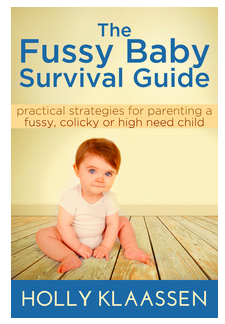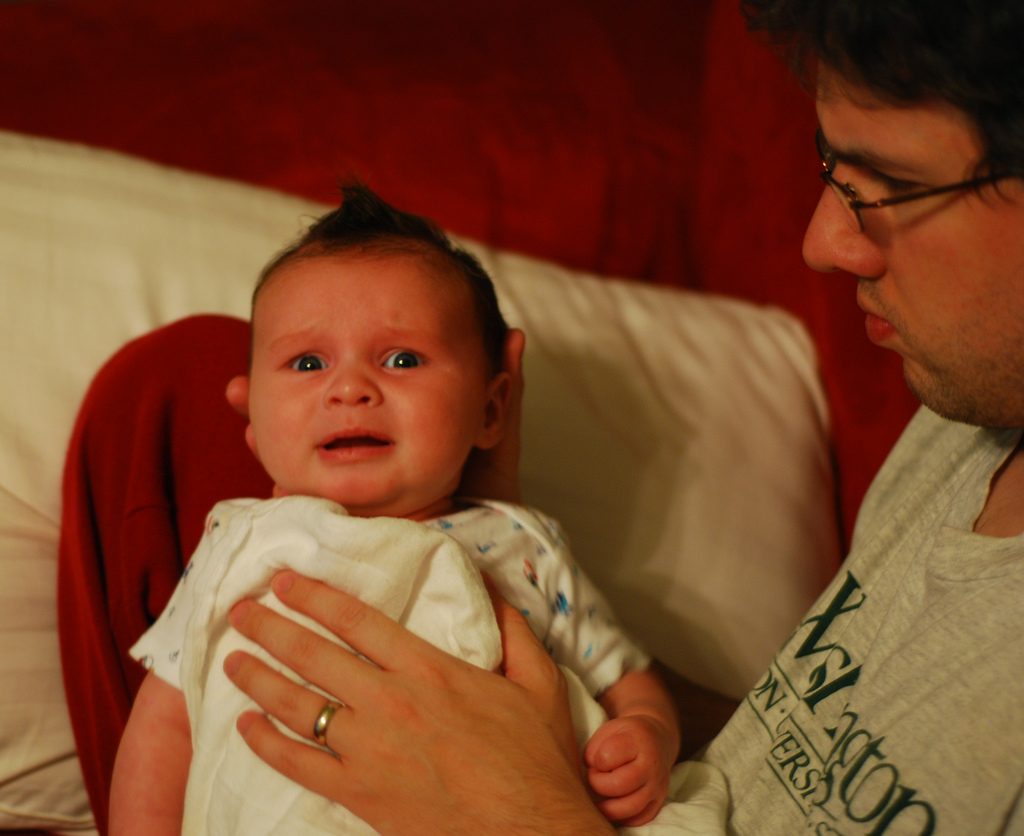- You are here:
- Home »
- The Complete High Need Baby Resource Guide
The Complete High Need Baby Resource Guide
“Dad, Please tell me I’m not high need!”
If you’ve only recently heard of the term ‘high need baby’, congratulations! Most parents only hear the term after months and months of wondering, “Why is my baby so much different than everyone else’s?”.
If you’re like most parents of high need babies, your story to date probably looks pretty much like this:
When your baby was born, you realized pretty much right away that something was…different. He likely cried, fussed and screamed from the day he was born, had troubles feeding and had very unpredictable sleep habits.
While your friends’ babies sat quietly in strollers, fell asleep in their cribs, and cried only from distinguishable causes, your little one as waking every hour at night, often feeding frantically, crying most of the day and pretty much inconsolable most evenings.
While other parents gushed, “Don’t you love being a mom?”, you harboured the silent fear that maybe, just maybe, you weren’t meant to be a mom. You had a deep fear that you were doing something wrong…”What kind of a mom doesn’t know what’s wrong with her baby?”, you thought.
You may have even felt like your baby hated you. Strong word, I know, but ones I’ve heard from more than a few parents. And ones I’ve felt myself.
So, what is a high need baby exactly? Let’s take a look.
[If you’re wondering if high need is really a ‘thing’, click here to find out what the research has to say: Is There Really Such a Thing as a High Need Baby?]What is a High Need Baby?
While “difficult” babies have been around forever, the term high need baby was termed by Attachment Parenting guru Dr. William Sears.
Dr. Sears and his wife, Martha, began to specialize in fussy babies when their fourth baby, Hayden, was born. While their first 3 children had been generally easy babies, Hayden was only happy when being held or fed. It was then that they realized that some babies are just truly high need.
Dr. Sears describes 12 features of high need babies, based on both what they experienced with their daughter, and what they have seen over the years in their pediatric practice. They note that all babies will exhibit some of these traits, some of the time.
He writes:
“All babies will show some of these features some of the time, and these features are descriptive only. As you will see, each of these personality traits has its blessings and its trials. These personality traits should not be judged as “good” or “bad.” They are just differences between babies, but these differences do make high need babies challenging to parent. Ultimately, what matters is how the child learns to use these special gifts. Our goal is to help parents identify these unique features in their infant and child and channel these traits to work to the child’s advantage.”
While my son was most of these things, I’m thankful that he wasn’t ALL of them! I know some of you are struggling with babies who meet all of these criteria, and I applaud you! By the way, at 7 years old, the only characteristic he still displays is being super-sensitive.
Following is a brief summary of the 12 traits of high need babies.
12 Characteristics of High Need Babies
Intense
Make their needs known in a very loud, definitive way. Are passionate about what they want and don’t want, and if you’re not quick to meet their needs, they’ll let you have it. They cry loudly, but the flip side is that they also voice their pleasure loudly.
Hyperactive
In constant motion, may have stiff or tense muscles, seldom quiet or still, and may even resist being held or cuddled. May resist being swaddled or wrapped, and may be difficult to breastfeed because of their constant movement.
Draining
High needs babies wear you down! They definitely keep you on your toes, and may leave little time for you to recharge your batteries. Because they often don’t sleep well, there is no consistent or predictable down time for you, the parent. This can be extremely tiring and frustrating.
Feeds frequently
High needs babies may desire to nurse or bottle feed more frequently. And you may also wish to feed more frequently to pacify your baby. I have heard from many parents that their high needs baby was in the top percentile for weight due to the high frequency of feedings.
Demanding
This is the child that lets you know, very loudly, what he needs. If you don’t get to him right away, he is quick to voice his displeasure. He feels his needs very strongly and knows how to get them met.
Awakens frequently
Sleeps in short stretches and may also have trouble falling asleep.
Unsatisfied
No matter what you do, your baby may still be grumpy, unhappy, or discontent, even if you’ve tried every calming technique you can think of. Dr. Sears encourages parents to realize when they’ve done all they can, and that the rest is up to their baby.
Unpredictable
One day she falls asleep when you rock her, the next she doesn’t. You’re able to calm her by feeding her one night, but the next night she shrieks when you try to feed her. He sleeps through the night for a few days, and then is up 3+ times the next few nights. We jokingly call our little guy manic depressive because he can go from calm and content and smiling one second to red-faced screaming the next.
Super-sensitive
Extremely sensitive to their environment and external stimuli. They are constantly observing the world around them, and prefer to be at home, or in a calm and familiar environment. They may startle easily, and are very sensitive to pain or discomfort.
Can’t put baby down
These babies prefer to be held and in constant motion. They may resist sleeping alone, or being relegated to their stroller or bouncy chair. They prefer human touch and movement. High Needs babies tend to do very well when being ‘worn’ in slings or baby carriers.
Not a self-soother
These are the babies that need help to fall asleep. While other babies may be able to drift peacefully off to sleep in their cribs, some babies need to be gently taught how to relax and fall asleep on their own. This may not come until a little later in infancy.
Separation sensitive
Some babies definitely prefer the company of their primary caregivers. It may be difficult to leave them with babysitters or even have someone else hold them. They are deeply attached to their parents as they know that these are the people who meet their needs.
Additional Traits of High Need Babies
In talking to many other parents, I have found several other traits that appear to be quite common in these high need babies:
Difficulty entertaining themselves
Many babies need parents’ help to keep them entertained, particularly before they are able to sit up on their own. However, what I hear from many parents of high need babies is that their baby continues to have trouble playing on their own even into toddlerhood. These babies are often not able to sit on the floor contentedly, even with age appropriate toys, without adult interaction. These babies seem to need the stimulation of interaction more than other babies.
Loves to be around people, noise and activity
While some high need babies do best in quiet, calm environments, what I hear from many, many parents is that their baby actually prefers being in crowds, surrounded by people and activity. They may cry and fuss significantly more in the quiet of their own homes. The activity and drone of crowds or traffic seem to soothe them, and they may even fall asleep. Friends and family may not believe your stories of crying and fussing because these babies appear so easy-going and content when in public
So, Is it Colic, Fussiness, High Need or a Spirited Temperament?
Ah, this is really the question, isn’t it? This is pretty much the goal of this entire site – to help you figure out why your baby is fussy and crying, and how you can cope with it.
That said, I’ll try to give a summary here of the differences, along with links you can use for further research.
Colic
This is the term you’re probably most familiar with. Colic is defined as 3 or more hours of crying, 3 or more days a week, for 3 weeks or more. I like the Mayo Clinic‘s description of colic, in particular. It acknowledges that there is more we DON’T know about colic than what we DO know:
“The cause of colic is unknown. Researchers have explored a number of possibilities, including allergies, lactose intolerance, an immature digestive system, maternal anxiety, and differences in the way a baby is fed or comforted. Yet it’s still unclear why some babies have colic and others don’t.”
Most typically, colic begins around 2-3 weeks of age (2-3 weeks adjusted age for babies born prematurely), peaks at 6 weeks of age, and is largely gone by 4 months of age.
Some of the most promising research to date points to a possible link between migraines and colic and to colic as a lack of a particular kind of gut bacteria in some babies. But even given the vast amount of resources that have gone into research over the past number of years, the causes of colic are far from clear.
Typically, colic is diagnosed when there is a lack of other symptoms that may indicate conditions such as reflux (GERD) or a sensitivity to dairy. This leaves many parents frustrated, as they may feel their concerns aren’t being sufficiently addressed.
High Need Babies
Parents will typically first hear the term ‘high need baby’ when their little one has reached 5-6 months of age, with little reprieve from the crying and fussiness. They have pinned all their hopes on the fact that colic ends at 3-4 months of age, and experience a deep sense of frustration and confusion when this doesn’t happen.
In my experience, 2 possible ways parents can distinguish whether their newborn baby has colic or a high need temperament are:
1. If their baby was fussy from day 1, this can sometimes signify a high need temperament rather than colic. Colic, on the other hand, tends to start at 2-3 weeks of age.
2. If there baby is fussy often during the day and night. Colicky babies tend to be relatively content during the day, and experience periods of crying, screaming or fussiness in the evening hours (the “witching hours” as they are sometimes called).
There are of course exceptions to these rules. However, from having talked with thousands of parents, these appear to hold true in a majority of cases.
High need babies will tend to exhibit many of the traits above (see the 12 Characteristics of the High Need Baby), and will be difficult to soothe, distract, and schedule during the daytime as well as during the night. Colicky babies, on the other hand, will have periods of extreme fussiness, coupled with periods of relative contentment.
The Spirited Child
Unless a child’s high need behaviours are caused by physical conditions such as reflux or a dairy sensitivity, they will often become what we refer to as ‘spirited’. The term ‘spirited child’ was coined by Mary Sheedy Kurcinka, and is described in detail in her wonderful book, Raising Your Spirited Child.
The term ‘spirited’ is used simply as a way of describing a particular set of temperament traits, much as ‘high need’ is used to describe similar traits in infants.

Some of the traits you may notice in a spirited child may be:
- Intensity
- Persistence
- Sensitivity, and
- Perceptiveness
You may also notice some ‘bonus’ characteristics such as:
- Being slow to adapt
- Being irregular in terms of routines and patterns
- Being slow to ‘warm up’
- Being perfectionistic or extremely serious
For a full description of the traits of the spirited child, please see these posts: Characteristics of the Spirited Child from Birth to Adult.
The Best High Need Baby Resources
Unfortunately, you’ve probably already discovered that there aren’t a lot of good resources online regarding high need babies. This is likely due, in part, to the fact that many, many parents never learn that the term ‘high need’ (or high needs) even exists.
That said, there are 5 great resources that may help you learn about and navigate through your own journey with a high need baby.
1. Dr. Sears on High Need Babies.
Dr. Sears is the definitive source on what constitutes a ‘high need’ baby. Having had a high need baby himself, he saw firsthand how challenging infants with these behaviours can be. He is also careful to point out that all babies – even non ‘high need’ ones – can exhibit these traits. The difference is that truly high need babies will exhibit many of them.
2. The Fussy Baby Survival Guide
If I could sit down with you over a cup of coffee, these are the things I would tell you! This eBook is a compilation of all the best tips and strategies I’ve learned over the past 10.5 years, including
- How to tell the difference between colic and a high need temperament
- The most effective soothing strategies for even the fussiest baby
- Best ways to help a high need baby sleep
- How to avoid and deal with tantrums
Check out The Fussy Baby Survival Guide here.
3. Quiz: Could You Have a High Need Baby?
Not sure if your baby qualifies as “high need’? While no one can definitively tell you either way, this quiz will give you a great place to start thinking about your baby’s temperament.
4. Sleep Training a High Need Baby
Is this even possible? What strategies can you use? What should you expect when helping your intense, persistent little one learn to sleep? This blog post will point you in the right direction!
5. Today’s Parent Magazine: High-Need Baby
This article, written in 2011, gives a great overview of the realities of life with a high need baby. Interviewing both parents and professionals, it gives parents a good idea of what others are going through, and how they can balance their own needs with those of their babies.
I was interviewed for this post, and I still hold fast to my quote from 3 years ago:
“There is hope! I often tell people I wouldn’t trade Sammy for anything. The temperament traits we saw in him as a baby are what make him such a fun, charming, exuberant little boy now. You can’t help but laugh when you’re with him!”
How Do I Cope With my High Need Baby?
In my experience, half the battle is adjusting your thinking and accepting your baby as he or she is. Realize that some babies just have a different temperament, and just need more attention right now.
Try to put aside the expectations and hopes you had for your baby when you were pregnant. Embrace the fact that your baby is who he is, but this isn’t how he will always be.
When your baby is screaming, strap her into the stroller, get yourself a coffee and go for a long walk. Don’t worry about your house looking perfect. In a few months, you’ll have more time for that. Arrange to have a babysitter a couple of times a week; don’t worry about your baby’s crying bothering the sitter. This is one day in her life, this is your every day. Order in dinner; the gourmet meals can wait a while.
But most of all, be gentle with yourself.
The expectations you may have had for what kind of mother you would be probably didn’t take into account having a high need baby. Don’t expect that you’ll always have warm, fuzzy feelings towards your little one. Enjoy the quiet, happy times you do have together right now.
Find ways to get through it.
I promise, it will get easier.
If you’re looking for more answers and guidance regarding your high need or fussy child, you might be  interested in my ebook, The Fussy Baby Survival Guide. It’s jam-packed with information, strategies, stories and the full results of two surveys I’ve done of parents of high need babies. It answers questions like:
interested in my ebook, The Fussy Baby Survival Guide. It’s jam-packed with information, strategies, stories and the full results of two surveys I’ve done of parents of high need babies. It answers questions like:
- How do I know if my baby is colicky, high need, or something else entirely?
- Will my high need baby ever get easier? And if so, WHEN?
- Is “high need” a real thing? Is there any research to back it up?
- What are the most effective strategies for helping my high need baby sleep?
- How do I deal with my child’s INTENSE tantrums?

